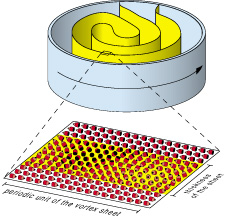EXPERIMENTS ON 3HE SUPERFLUIDS
Background
The ROTA project, a Finnish-Soviet collaboration, was the first to start studies of quantized vortex lines in the superfluid phases of liquid 3He. In 1981 the construction of our first rotating nuclear demagnetization cryostat was completed. Much of the ROTA work has concentrated since then on identifying the topology and structure of different objects in the superfluid order parameter field, formed in the rotating state. 3He is the most versatile laboratory system where such principles as topological stability and confinement, nucleation of singularities, and interactions between objects of different topologies can be investigated.

Vortex sheet, first predicted by Lars Onsager in 1949, was found to be stable in 3He-A in 1993 by experiments conducted by the LTL.
Further Reading
[1] O.V, Lounasmaa, and Erkki Thuneberg, Vortices in rotating superfluid 3He, Proc. Natl. Acad. Sci. USA 96, 7760 (1999).
[2] V.M.H. Ruutu, Ü. Parts, and M. Krusius, NMR signatures of topoligical objects in rotating superfluid 3He, J. Low Temp. Phys. 103, 331 (1996).
[3] V.M.H. Ruutu, J. Kopu, M. Krusius, Ü. Parts, B. Plaçais, E.V. Thuneberg, and Wen Xu, Critical velocity in rotating superfluid 3He -A, Phys. Rev. Lett. 79, 5058 (1997).
Topological defects in 3He
Quantized vortex lines can have different structures in the 3He superfluids. For example, in the vortex core the order parameter may become singular or it may have a continuous singularity-free distribution. The more familiar vortices of superfluid 4He and of conventional superconductors belong to the former class. In the 3He superfluids, singular vortices with four different core structures have been identified. Vorticity with continuous structures dominates in 3He-A, where it appears either as isolated vortex lines, each comprising of two quanta of superfluid circulation, or as a vortex sheet or a nearly uniformly distributed in homogeneous structure.
Altogether eight different types of quantized vortices have been discovered in the LTL: four continuous and one singular structure in 3He-A and three singular structures in 3He-B [1]. The majority of our work so far was focused on vortex textures to determine their topology and structure. Different NMR absorption spectra of 3He-A are illustrated in the figure of left. In all cases, the large main peak is shifted towards higher frequencies by about 15 kHz from the Larmor value. The satellite peaks on the low frequency side are caused by the presence of vortices. They correspond to spin-wave modes localized in the soft vortex cores [2].
In 1993 we discovered the vortex sheet in 3He-A. The concept is an old one. Cylindrical vortex sheets were proposed by Onsager and by Fritz London in the late forties as the first at-tempt to explain the mysterious flow properties of 4He, the only superfluid known at that time. The model was further developed by Landau and Lifshitz who calculated the separa-tion between the vortex cylin-ders. In the 4He superfluid, however, the vortex sheet is unstable and breaks into separate vortex lines.
We discovered that in 3He-A the vortex sheet is stable. Its macroscopic structure in a ro-tating container is illustrated in the upper figure on right. The backbone of the sheet is a two-dimensional soliton, initially present in a stationary container. When rotation is started, it is easier to form vortex quanta within the existing soliton rather than to nucleate separate vortex lines, which involves a higher energy barrier. In this way continuous vorticity is added to the soliton, which develops into a vortex sheet and grows with increasing rotation velocity be-cause vortices repel each other when their density is too high. This leads to folding of the vortex sheet. The number of convolutions increases with the speed of rotation; at W = 1 rad/s, the distance between the folds is 350 mm, 10 times more than the thickness of the sheet.
Present and Future Challenges
In 1993 we started using superconducting LC resonators in the NMR tank cir-cuit. This increased the Q-value of the system by an order of magnitude to 2000 and made possible measurements with single-vortex resolution in 3He-B (lower Figure on right). In 1998 the Q-value was increased to 20000, which allowed the first measurements in 3He-A with a signal-to-noise resolution of roughly unity on the response from one vortex [3]. During constant slow rota-tional acceleration new vortex lines are regularly formed. This periodic signal can now be distinguished and, as expected, the super-fluid circulation of the vortex line with a dipole-unlocked continuous structure was determined to correspond to two quanta. With the increased sensitivity it was also established that vortex lines and the vortex sheet both give rise to a sinusoidal signal in 3He-A when the rotation velocity is harmonically modulated with an amplitude which is so small that circulation is neither nucleated nor annihilated.